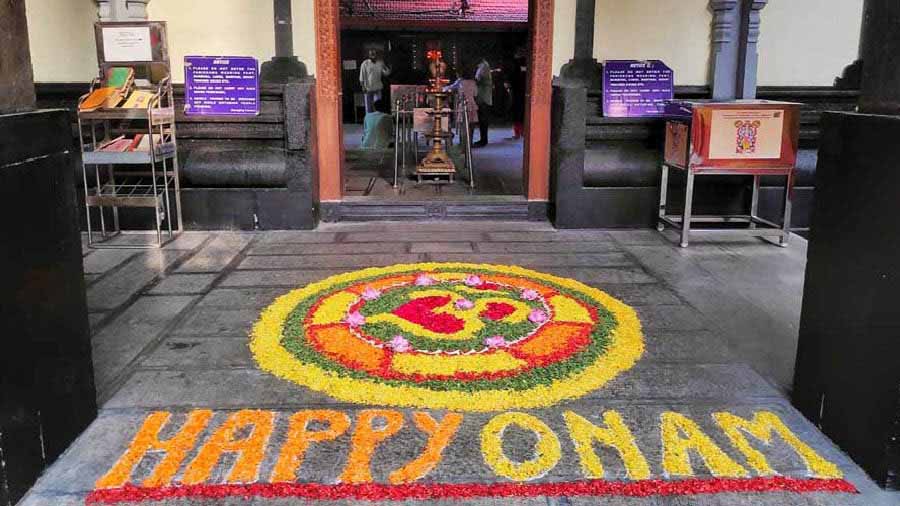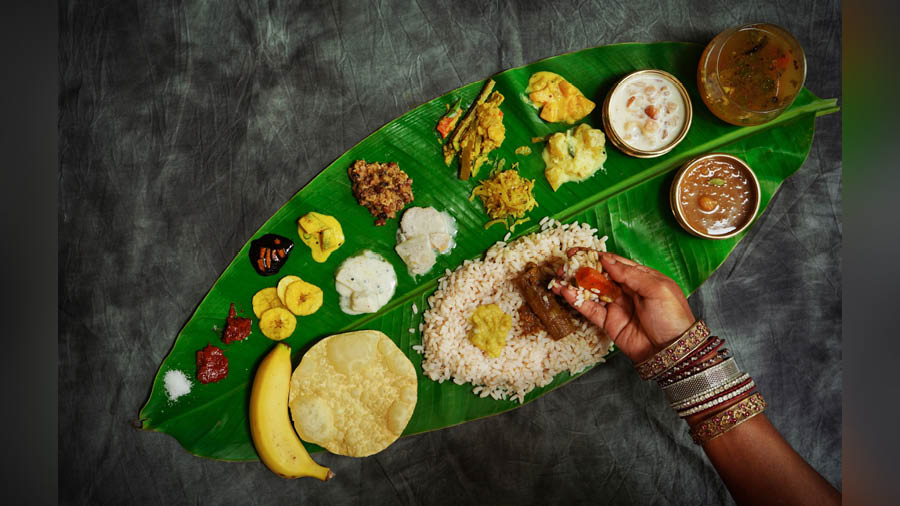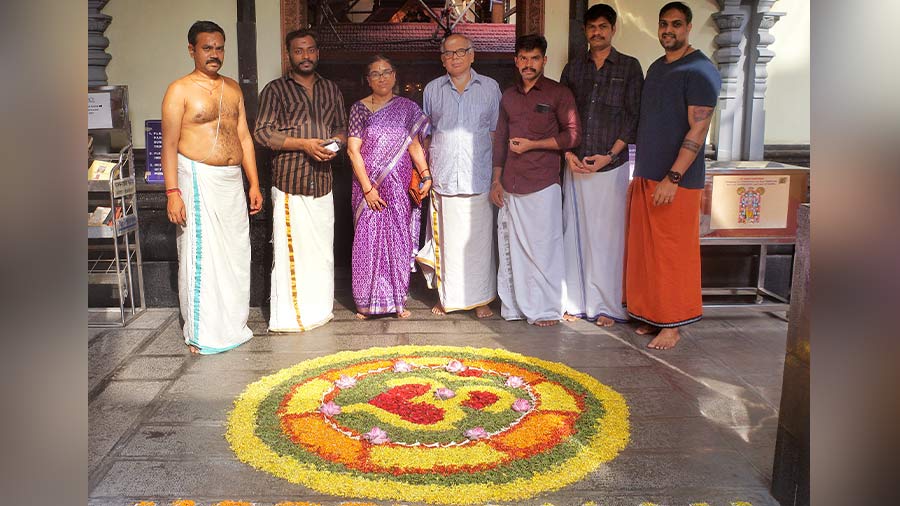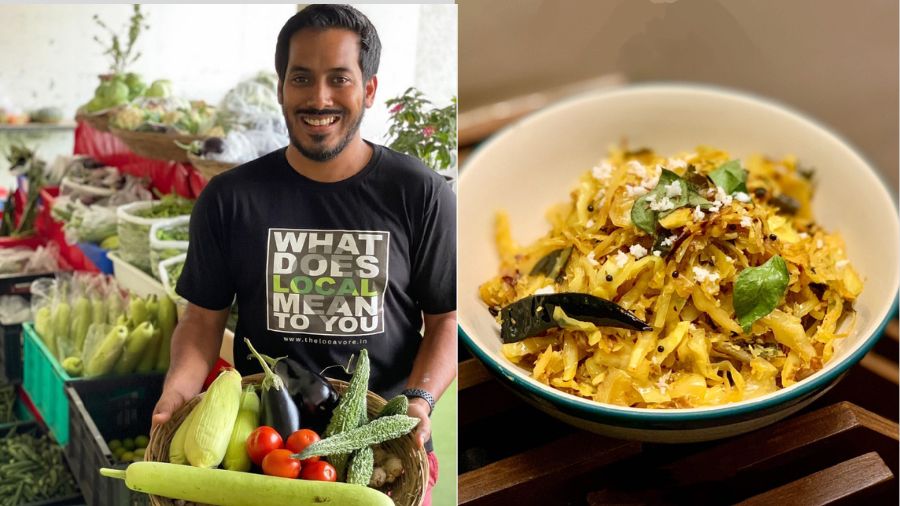In the heart of Kolkata, the spirit of Onam comes alive as Malayalees celebrate the harvest festival with fervour and unity. This 10-day celebration embraces harmony, diversity and togetherness.
Onam celebrations in Kolkata started on the last Sunday of August, and will continue till September 17. Kolkata boasts numerous Malayalee organisations where the festival is celebrated every Sunday for six weeks, evoking the nostalgia of childhood days. The most important day of the festival is Thiruvonam, which falls on August 29 this year.
Join us as we connect with three Malayalees living in Kolkata, who share their personal insights into what Onam means to them and how they celebrate this occasion. Their stories are accompanied by delightful recipes that carry the authentic flavours of Onam straight to your table. Be sure to explore these delicious dishes!
Krishna Nair, general secretary, Keraleeya Mahila Samaj Kolkata
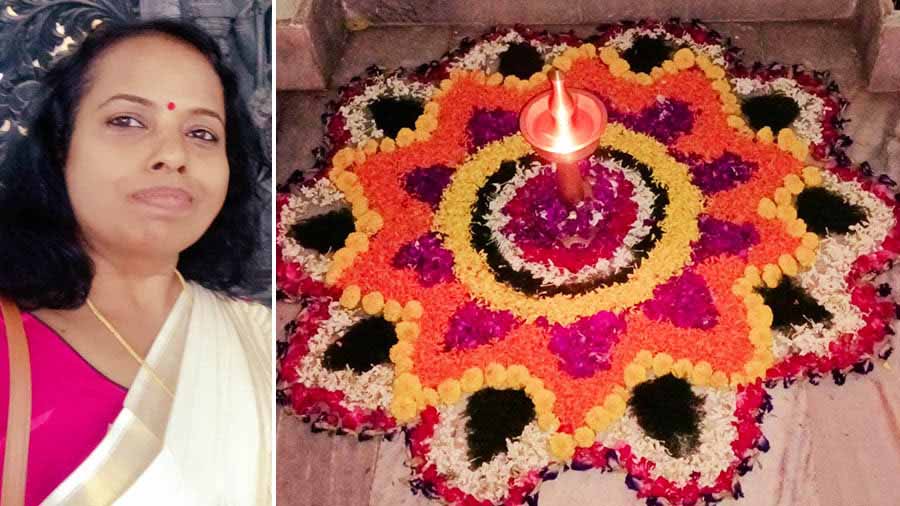
Krishna Nair and the 'pookalam' at her home
First of all, let me wish a very Happy Onam to everyone! We, the Kolkata Malayalees, celebrate Onam with lots of love and passion. On this day, we celebrate at home with our near and dear ones with a grand feast known as Onam Sadya. A variety of food, from crispy papadum to several delectable dishes like pachadi, sambhar, thoran, aviyal, kalan, olan etc and also dessert, are included in this elaborate vegetarian meal, which is served on a banana leaf. Early in the morning, we use fresh flowers to create ‘pookalam’ or flower rangoli that we arrange in lovely patterns to decorate our home. These colourful floral arrangements not only showcase the artistic creativity of the people, but also symbolise a warm welcome to King Mahabali. On this day, we dress up in new clothes, visit our loved ones, enjoy regional dance and music, make pookalam, eat Onam Sadya, and enjoy to the fullest.
Though I work for a multinational company, I have taken leave for Thiruvonam to celebrate at home. Onam serves as a gentle reminder that no matter how far we travel, our cultural history will always keep us connected to our roots as the aroma of flowers fills the air and the beat of traditional drums reverberates. It’s a moment to revel, cherish, and embrace Kerala’s diverse cultural heritage.
Krishna’s refreshing Olan recipe

Olan curry Shutterstock
The delicately-flavoured Olan curry stands as an essential component of the Onam Sadya, complementing rice perfectly with its light and refreshing nature. This simple recipe is ideal whether you’re seeking lunch on a sweltering summer day or aiming for a light and quick weeknight dinner.
Ingredients
- Diced ash gourd: 2.5 cups
- Red cowpeas, soaked overnight: 1/4 cup
- Thick coconut milk: 1/2 cup
- Thin coconut milk: 1/2 cup
- Green chilli
- Curry leaves
- Sugar
- Salt
- Coconut oil
Method
- Pressure cook the peas for 1 whistle
- Add 2.5 cups of diced ash gourd, four green chillies, salt and 1/2 cup thin coconut milk.
- Again, pressure cook for one minute.
- Gently smash the ash gourd. Add 1/2 tsp sugar and salt (if needed).
- Then add 1/2 cup thick coconut milk and curry leaves and allow it to heat. After 2-3 whistles on full flame, switch off the fire and add 1/2 tbsp coconut oil.
- Mix everything well and your tasty Olan is ready!
Prabha Menon, resident of Lake Gardens

Prabha Menon
Here, in Kolkata, we are blessed to have several Malayalee associations conducting the grand Onam Sadya on the weekends after Thiruvonam to allow one and all to gather, irrespective of their religion, caste or creed. People joyfully and enthusiastically look forward to this gathering and enjoy not only the traditional lunch, but also live music and dance.
My childhood memories of Kerala are very exciting. We would collect various colourful flowers from our backyard and make simple rangoli with flowers (pookalam) at the entrance to our house. We would wear new clothes, and meet our relatives and friends. Elders would prepare a lavish meal or sadya, mostly vegetarian. After that, ladies would get together, wearing traditional ‘set mundu’ and perform a dance or ‘Kaikottikali’ where they clap hands and dance in a circle around a lamp. Trained artists may also perform ‘Puli Kali’ or tiger dance to entertain people. They would paint themselves like tigers (puli) and perform this folk art. In Kerala, we also have the famous ‘Vallam Kali’ or Snake Boat race during this time.
Prabha’s family recipe of Aviyal
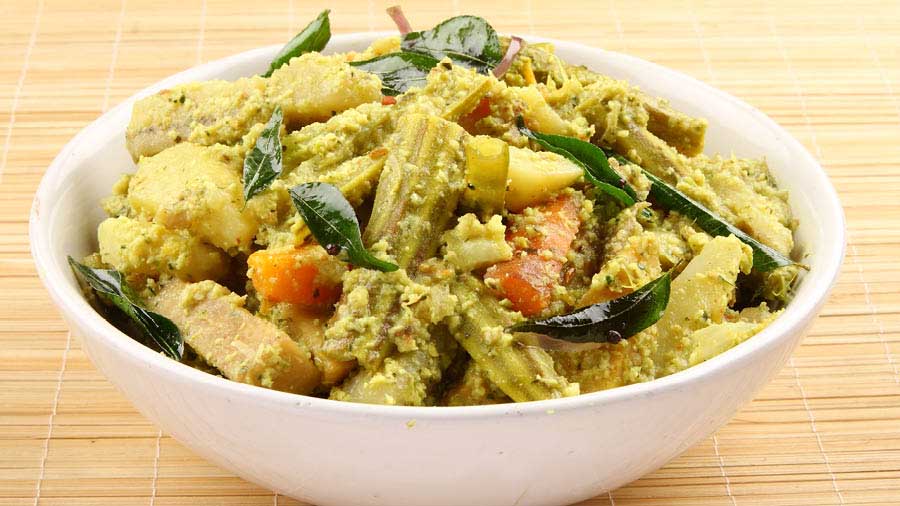
Aviyal Shutterstock
Aviyal is a unique traditional dish of Kerala and no feast or sadya is complete without Aviyal. Aviyal is loved for its special flavour and is a thick mixture of different vegetables and coconut, curd (optional) and seasoned with coconut oil and curry leaves.
Ingredients
- Raw banana: 1
- Yam: 1/2 cup
- Drumsticks: 2
- Cluster beans: 1/4 cup
- Snake gourd: 1/4 cup
- Carrot: 1 cup
- Madras cucumber: 1 cup
- Raw mango : 1/2 cup or curd : 3 tbsp (lightly sour)
- Turmeric powder : 1/2 tsp
- Coconut grated: One and half cup
- Green chillies: 4 - 5
- Cumin seeds: 1/2 tsp
- Curry leaves: 1 sprig
- Coconut oil: 1 tbsp
- Salt to taste
Method
- Peel and cut vegetables lengthwise into one-and-half inch pieces (stick shape)
- Wash, cover and cook vegetables with half cup water, turmeric powder and salt to taste till the vegetables are half cooked (do not over cook the veggies; keep adding the veggies according to their cooking time).
- Add sliced mango pieces with the skin and stir
- Add the ground coconut (make a coarse paste of grated coconut, cumin seeds and green chillies with very little water)
- Cover the vessel and cook for 5 minutes
- Add curd now (if raw mango is not used) and mix well
- Add the curry leaves and pour some coconut oil over the top. Mix well and cover it.
- Remove from the fire
Jayasree Kumar, resident of Behala
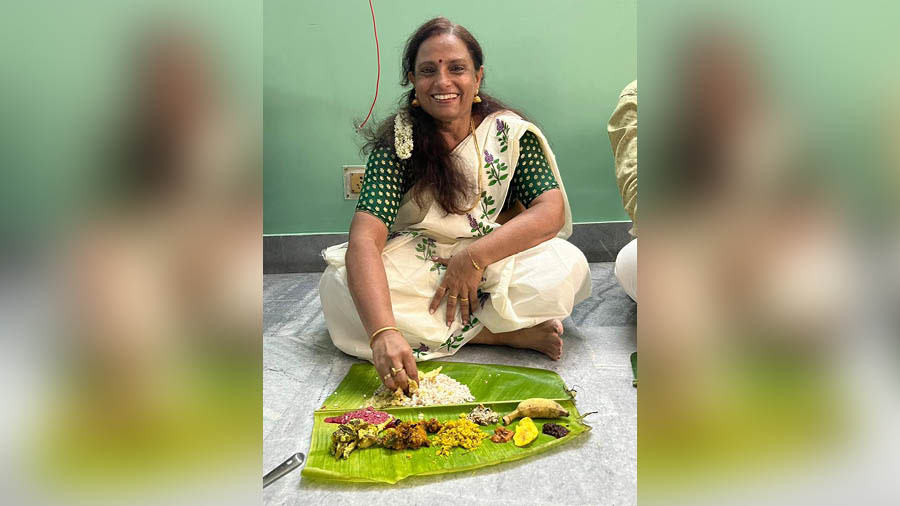
Jayasree Kumar enjoying her Onam Sadya
Onam, a harvest festival observed in Kerala during August or September, extends across 10 days. It also symbolises the return of King Mahabali. Onam is celebrated with much joy throughout the state, embraced by Malayalees of all faiths, castes, and backgrounds. In Kolkata, we embrace Onam with happiness. Our homes come alive with flower rangoli adorning the entrance. Decked out in new attire, we prepare a delectable sadya featuring an array of 10 to 12 vegetable curries, accompanied by the essential payasam. The meal is served on a traditional banana leaf. The entire day is devoted to family time and we reconnect with our loved ones. Kolkata has many Malayalee organisations where we celebrate Onam every Sunday for six weeks, evoking the nostalgia of our childhood days.
Jayasree’s recipe for Mathanga Erissery
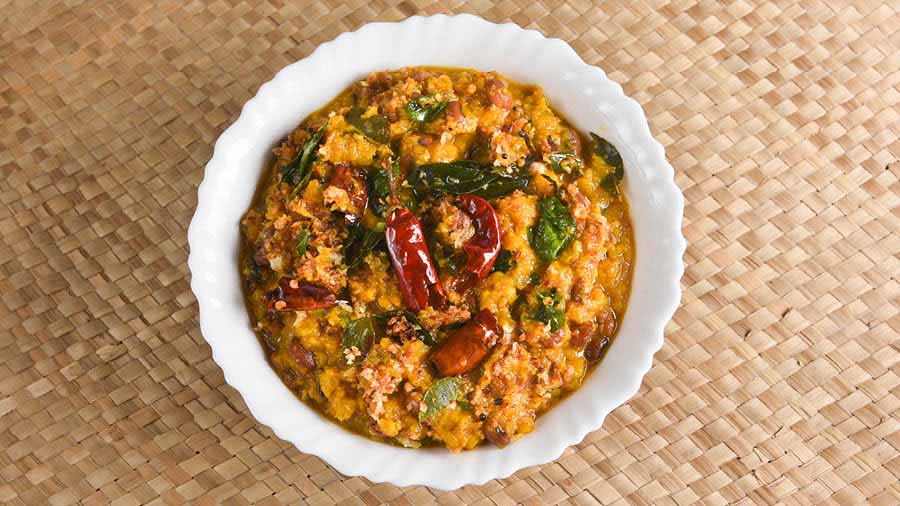
Mathanga Erissery Shutterstock
Mathanga Erissery is a comforting south Indian dish featuring tender pumpkin cooked in a fragrant coconut-spice blend.
Ingredients
- Vanpayar or red cowpeas
- Mathanga (yellow pumpkin)
- Coconut, grated: 1-1/2 cups
- Jeera: 1 tsp
- Garlic: 3 cloves
- A few pieces of black pepper
- Red chilli powder: 1 tsp
- Turmeric: 1/2 tsp
- Salt to taste
Method
- Boil Vanpayar in a pressure cooker adding salt, turmeric powder and chilli powder.
- Add the pumpkin to the Vanpayar and cook till the pumpkin is done.
- In a mixer grinder add one cup of grated coconut, jeera, garlic and a few pieces of black pepper. Grind it coarsely and add to the boiled Vanpayar and Pumpkin. Mix nicely.
- Now add 2 tsp coconut oil in a kadai and put a teaspoon of urad daal, mustard seeds and two dry red chillies and curry leaves.
- When it sputters, add half a cup of grated coconut and fry till it turns brown.
- Finally add the boiled Vanpayar and Mathanga and mix nicely. The curry is ready to serve.
